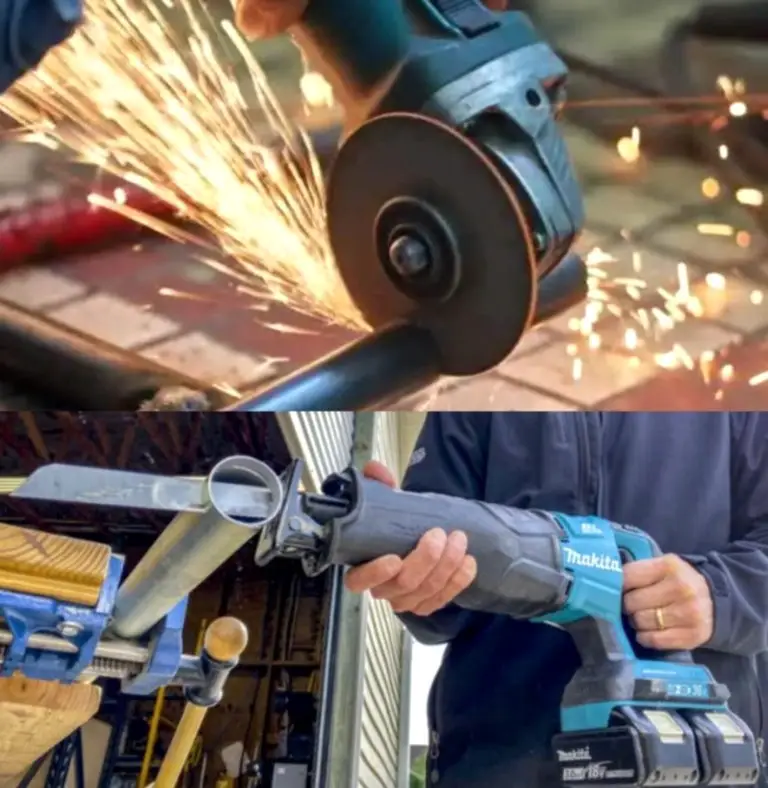Angle grinders and reciprocating saws are among the most popular tools for cutting hard materials including metal. With an ever-increasing variety of blades for both tools, you might be wondering how an angle grinder is different from a reciprocating saw.
Therefore, our article will focus on angle grinder vs reciprocating saw to compare and contrast the two tools’ capabilities.
Angle Grinder Vs Reciprocating Saw: In-Depth Comparison
| Angle grinder | Reciprocating saw | |
| Cutting materials | Hard & tough materials | Practically anything |
| Cutting capacity | Lower (often 1-2.5”) | Greater (up to 12”) |
| Blind cuts | Yes | No |
| Plunge cuts | Yes | No |
| Curved cuts | Hard to do | Yes |
| Applications | Extremely hard materials cutting; General metal projects | Multi-material cutting; Soft material cutting; Demolition work |
| Level of noise | Higher | Lower |
| Dust | More | Less |
| Sparks | More | Little or no sparks |
| Safety issues | Higher | Lower |
| Price | Wide range | Wide range |
| Compatibility | Smaller & lighter | Marginally larger & heavier |
1. Materials to cut
- Reciprocating saw
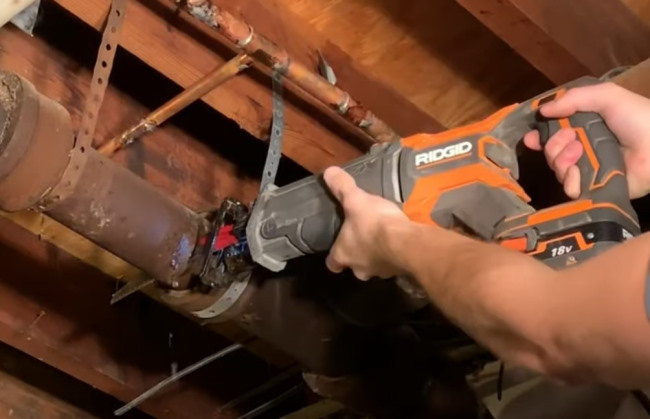
With the right blade, a reciprocating saw may be used to cut practically anything.
Bimetal blades allow it to cut wood, plastics, and softer materials like copper, mild steel, aluminum, and brass. Moreover, with premium carbide-bimetal discs, it can cut through stainless and hardened steel.
Tougher materials like masonry, cast iron, concrete, and most composites can also be cut with carbide/diamond grit discs.
- Angle grinder
On the other hand, most popular metals can be cut with angle grinders’ aluminum oxide cutoff wheels. Therefore, they are a straightforward choice for hard and tough materials because you don’t have to worry about the disc type that you have mounted.
Some materials, such as concrete, masonry, and stainless steel may necessitate cutoff blades with harsher abrasives or a tougher binder.
Nevertheless, angle grinders are not suitable for cutting soft materials including wood or plastics since their standard cutoff blades have the tendency to burn/melt the workpiece rather than cutting it.
An angle grinder with specific saw blades or chainsaw-teeth wheels may cut these soft materials, but it is inconvenient and dangerous to use.
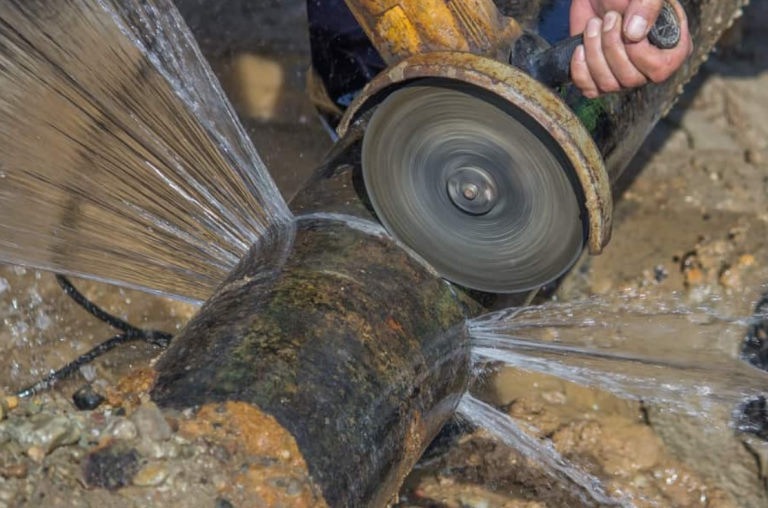
2. Cutting capacity
A tool’s cutting capacity refers to the max thickness of the object that it can cut.
In theory, the blade length of a saw determines its cutting capacity. Since the blades of this tool come in a variety of lengths with a maximum of 12 inches, its typical cutting capacity can reach 10 or 11 inches.
An angle grinder’s cutting capacity is lower than a reciprocating saw’s and limited by its cutoff blade’s reach.
Different from the saw, the grinder’s disc size is limited and dependent on the grinder model. The tool’s disc diameters range from 4.5” to 7”, corresponding to a cutting capacity of 1” to 2.5”.
Large gas-powered grinders can have wheels as large as 14-inch diameter, which gives you a 6-inch cutting capacity.
3. Cutting geometry
Blind cuts
These are the ones in which the saw doesn’t entirely cut through the workpiece from the cutting side. When creating slots, grooves, and pockets in a workpiece, blind cuts are frequently required.
Since a reciprocating saw’s blade is straight, serrated along its side, plus requires space to move, the tool is terrible at making blind cuts. With this type of saw, you might be able to create some blind cuts in soft materials, but the cuts won’t be clean or consistent.
On the contrary, an angle grinder can blind cuts since the disc’s cutting edge can penetrate the material while still performing the rotary cutting operation.
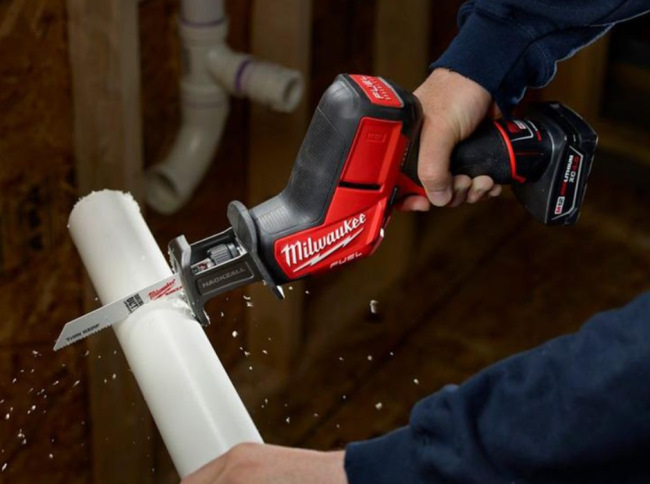
Plunge cuts
A plunge cut refers to one that begins anywhere in the center of a workpiece rather than near the edge. When producing holes and cutouts, plunge cuts are frequently required.
Similar to blind cuts, plunge cuts are difficult to perform with a reciprocating saw, but they are simple to make with an angle grinder. A pilot hole should be drilled to assist a reciprocating saw in making plunge cuts.
Curved cuts
A curved cut refers to one that does not have a straight cut line. Most reciprocating saw blades are suitable for creating curved cuts because they are short and take up little space to turn during the cuts.
The angle grinder’s wheels take more space inside the cutting line. Also, it can barely turn without rubbing on cutting faces, hence, the tool can’t really create curved cuts.
4. Application
Reciprocating saw
- Multi-material cutting: The power tool is ideal for cutting multiple materials in a row or single workpieces made up of multiple materials.
- Soft material cutting: Reciprocating saws are significantly better at cutting soft materials such as wood, foam, and plastics than angle grinders.
- Demolition work: When working with materials that are either soft or hard and must be cut right away, reciprocating saws are preferable. Angle grinders’ sparks can present a fire hazard, which could limit their use in demolition sites.
Angle grinder
- Extremely hard materials: Angle grinders are capable of cutting the toughest steel with ease, as well as concrete, stone, and rock. These can’t be done as effectively with reciprocating saws, at least when you don’t use rare diamond grit discs.
- General metal projects: Grinders are preferable for general metalworking because they can grind, polish, sand, and deburr besides cutting.
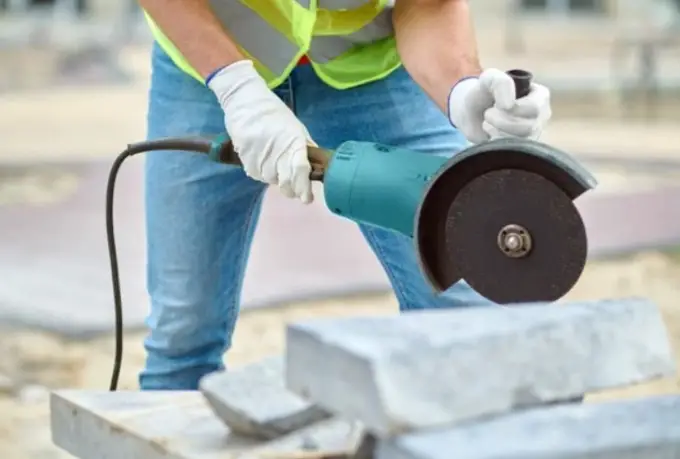
5. Other issues
Level of noise
The levels of noise reported from both power tools range from 80 to 110 bB(A), which makes both quantitative & representative comparisons difficult.
Furthermore, a single decibel rating does not convey the whole extent of danger or irritation caused by a power tool’s noise.
Generally, most people consider an angle grinder to be noisier and more irritating than a reciprocating saw, which can be explained by the actual decibel levels, the higher pitch, and other aspects of its noise spectral content.
Hearing protection is required for both power tools, but the angle grinders’ higher noise level can make them less comfy for both their operator and the environment than reciprocating saws.
Dust
Angle grinders produce a larger amount of finer dust than reciprocating saws.
This kind of dust is easier to disperse and leads to more health problems when it enters our human body, which makes the grinders larger occupational health problems.
On the contrary, reciprocating saws generate a considerably smaller amount of dirt and turn a majority of the discarded material into bigger chips. This debris falls to the surface quickly, causing much less damage to health than fine dust.
Sparks
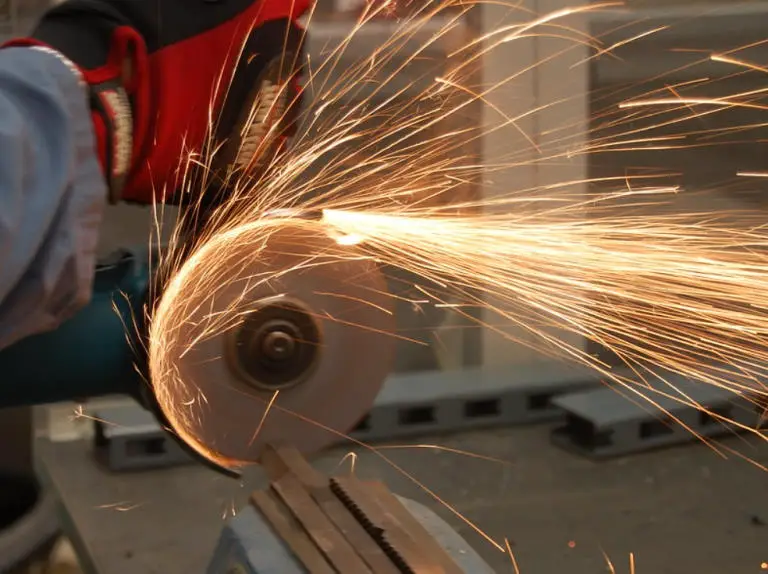
Besides dust, angle grinders produce lots of sparks while cutting ferrous alloys such as cast iron and steel. Sparks caused by cutting operations can damage surfaces and pose a fire hazard.
Because of sparks, the usage of this tool is generally considered hot work. It means that this type of work may necessitate additional precautions, including hot work permits and fire meters. These precautions depend on your industry and the jurisdiction.
On the other hand, reciprocating saws, even when used to cut steel, produce little or no sparks. For this reason, they are better than angle grinders, based on a fire safety viewpoint.
Therefore, reciprocating saws are often seen as a fire-safe solution to angle grinders.
Safety issues
Using both angle grinders and reciprocating saws pose injury risks, however, they have moderately different hazard profiles. These power tools can cut your hands or some other parts of your body. They can also kick back and send workpiece flying or chips to you.
Due to the significantly higher speed, angle grinders’ hazard potential is somewhat higher. Grinders also have a risk of burns and spark fires.
However, the highest risk with angle grinders is a broken disc, which can send shrapnel at high speeds towards their operator or bystanders, causing serious injury. Even though you can minimize this risk by using appropriate disks and a disk guard, you cannot completely eliminate it.
By contrast, reciprocating saws move more slowly and because of their low kinetic energy, they are significantly less risky. There is a risk of injuring your fingers due to accidental handling while you change the tool’s blades.
Price/Cost
Both power tools are relatively similar in price. While their prices certainly depend on specific make and model.
However, the difference in prices can be too narrow to affect your consideration.
Compatibility
On average, reciprocating saws are marginally larger and heavier than angle grinders. Each power tool comes in various sizes and capacities, however, the mid-range saws are commonly drastically larger than the grinders of the same size.
Read more: Angle Grinder vs Oscillating Tool: What Is The Difference?
Related Questions
1. I had an angle grinder, should I buy a reciprocating saw?
With an angle grinder, you can do a majority of metal cutting. If you mainly cut small parts in your mortal or on the job site and you don’t mind sparks, a grinder may be enough and you don’t need a reciprocating saw.
However, angle grinders are not suitable for cutting large cross-sections or soft materials. If you often have to cut large-diameter metal workpieces or wood, and plastics, purchase a reciprocating saw.
Also, select the saw for cutting metal if the sparks from your grinder can lead to a fire hazard in the place where you work.
2. I had a reciprocating saw, should I buy an angle grinder?
Your reciprocating saw can do most cuts for you whether the material is wood, metal, or composites.
While specific blades may be needed for materials such as hardened steel, concrete, the power tool can handle them. You will hardly need a grinder to cut such materials.
Nevertheless, you need an angle grinder if you have to grind, sand, or polish your workpiece since these tasks are completely impossible with your reciprocating saw.
3. Which one should I get first?
The answer depends on the kind of work that you want to do with your tool.
If you are seeking a versatile cutter for a job site, your shop, or around the house, our recommendation is a reciprocating saw. It can cut through more materials, possesses a higher cutting capacity, plus has few safety issues.
On the contrary, angle grinders will cut all types of steel and other metals with no problem, and can do grinding, sanding, and polishing.
Therefore if you are wondering to buy whether an angle grinder or reciprocating saw to cut metal, your first choice should be the former.
Final Words
After reading our detailed comparison between angle grinders and reciprocating saws based on various aspects, you can see that the latter is an all-around power tool for your workpieces made from any material, shape, and size.
By contrast, angle grinders are ideal for metalworking and useful not only in cutting but also in grinding, sanding, and polishing.
